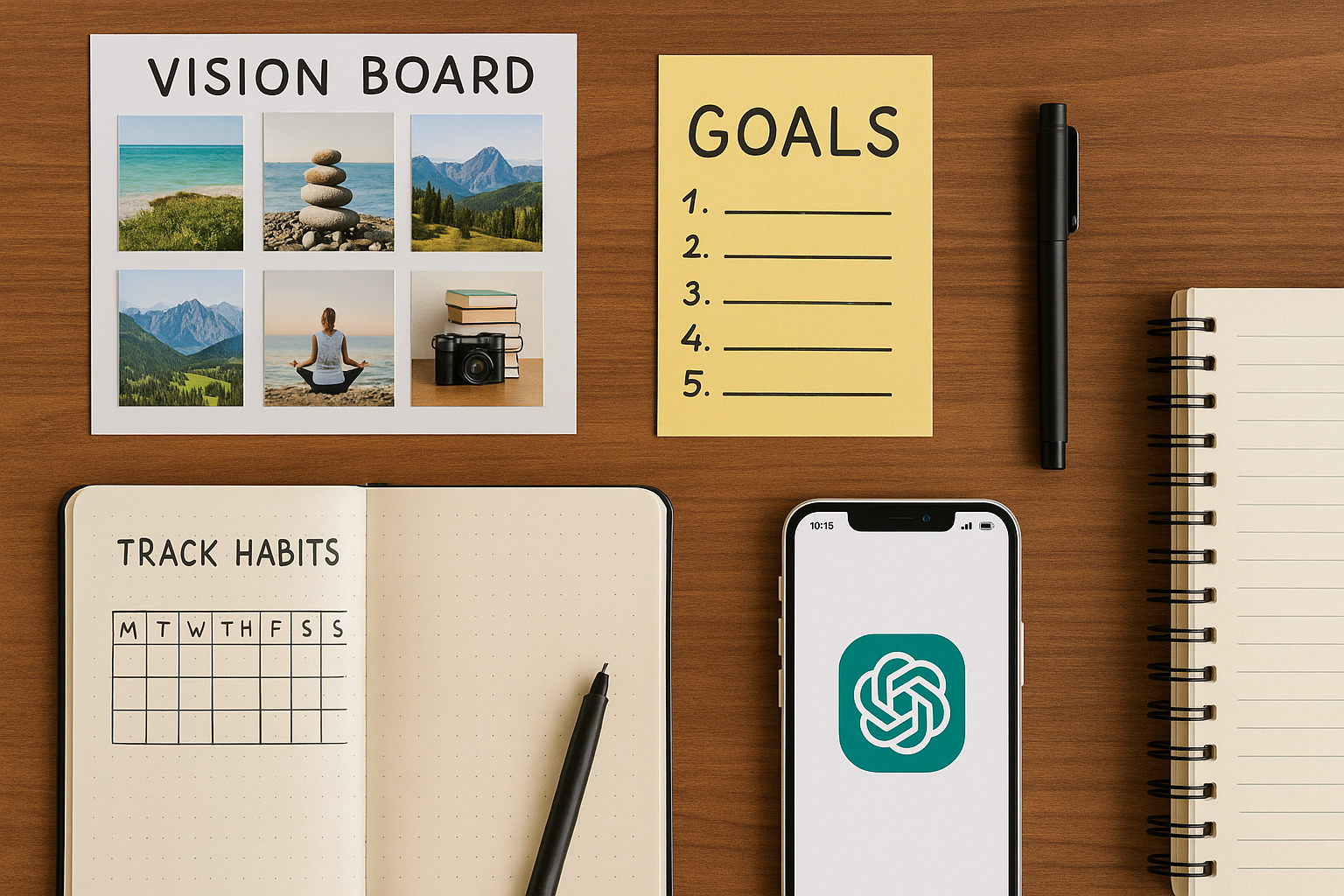Goal setting isn’t just about writing down ambitions. It’s about using the right tools that help you define, pursue, and accomplish what you aim for. Some people swear by vision boards. Others prefer spreadsheets, journals, or habit-tracking apps. And then there are AI assistants, quietly taking up space in our workflows, ready to prompt, plan, and predict.
So, which tools actually move the needle?
Below is a breakdown of tools that don’t just look good on paper but actually help you build momentum.
1. Vision Boards: Goal Setting Through Visualization
Vision boards have endured for a reason. They turn abstract ideas into visible targets. Whether physical or digital, vision boards help clarify intent and inspire regular reflection.
Benefits:
- Keeps goals in sight—literally.
- Activates visual memory.
- Can trigger emotional motivation.
Use it best for:
- Long-term dreams.
- Personal life changes.
- Creative direction.
Pro tip: Combine vision boards with monthly reviews. Ask yourself, “What on this board moved closer to reality?” Then adjust.
2. Bullet Journals: Tracking Goals with Paper and Pen
The bullet journal offers structure without rigidity. It’s flexible, creative, and deeply personal. Habit trackers, weekly logs, mood spreads—everything can be tailored to how your brain works.
Why it works:
- Forces reflection through manual effort.
- Creates a rhythm of planning and review.
- Builds accountability through self-checks.
Best used for:
- Daily routines.
- Habit stacking.
- Mindset tracking.
Drawback: It’s manual. Skipping a few days might lead to abandoned pages.
3. SMART Goals: Bring Structure to Your Intention
The SMART framework is time-tested. Goals should be Specific, Measurable, Achievable, Relevant, and Time-bound. It turns ideas into roadmaps.
Why people use it:
- Helps cut vague goals into bite-sized tasks.
- Built-in criteria prevent overpromising.
- Ideal for professional development and career targets.
How to apply:
Instead of “Get fit,” write “Exercise three times a week for 45 minutes for the next 90 days.” Then plug that into a habit tracker or app to maintain visibility.
4. Habit Tracking Apps: Numbers That Nudge
Apps like Habitica, Streaks, and Done turn habits into mini-games. The dopamine loop from seeing your streak grow can be highly effective. They quantify discipline and offer a daily reminder of your direction.
Why it sticks:
- Instant feedback.
- Easy visual overview.
- Works on phones—your constant companion.
Try it with:
- Sleep schedules.
- Fitness routines.
- Water intake or screen time limits.
5. Accountability Partners: The Human Factor
Sometimes a calendar reminder isn’t enough. Sharing your goals with a trusted partner adds real-time pressure. Whether it’s a friend, coach, or coworker, this method thrives on mutual engagement.
Why it helps:
- Encourages verbal commitment.
- Adds social pressure without punishment.
- Allows brainstorming and feedback.
Set it up with:
- Weekly check-ins.
- Shared documents.
- Penalties or rewards for milestones.
6. AI Assistants: Guidance in the Gaps
AI tools have quietly become some of the most effective goal-support systems. Whether you use structured planners or conversational models, they remove friction from planning and give structured feedback on the fly.
You can now chat with ChatGPT 4o to brainstorm action steps, review performance metrics, or simulate possible obstacles to your goals. These tools don’t replace traditional methods like vision boards but can complement them—helping you articulate clearer goals, track results, or preview future outcomes through simulations.
Use AI to:
- Break down goals into weekly tasks.
- Get reminders or rewrites of your mission.
- Evaluate what’s working based on behavior patterns.
7. Quarterly Planning: 12 Weeks Over 12 Months
The 12-Week Year concept flips the annual resolution idea on its head. Instead of vague December goals, you reset every three months. It compresses urgency and builds focus.
Why short cycles win:
- More review points.
- Less fatigue over long timelines.
- Encourages sharper execution.
Structure:
- Define a 12-week outcome.
- Pick 3–5 key habits that drive it.
- Weekly plan and reflect.
8. Simulation Tools and Decision Trees
For those managing complex goals with multiple outcomes—business launches, relocations, investment planning—simulation-based tools let you see ahead.
Tools like Trello combined with forecasting models or decision-tree templates let you:
- Map outcomes.
- Stress-test strategies.
- Identify blockers before they arise.
These visual planning formats are great for people with non-linear goals.
9. Mind Mapping: Freeform with Focus
Mind maps let ideas branch from one core theme. For goals that feel tangled, this method allows structure to emerge naturally.
Ideal for:
- Starting from scratch.
- Merging multiple ambitions.
- Strategic planning with visuals.
Tools like XMind or simple pen-and-paper setups make this a low-barrier way to think expansively and organize later.
10. Goal Cards: Daily Anchors
Write one goal per index card and place them where you’ll see them: mirror, wallet, dashboard, desk. Simple. Analog. Persistent.
Why it works:
- Gentle daily reminders.
- Easy to rotate or update.
- No battery required.
Pair with a short journal entry or a checkmark system on the back to build a rhythm.
Which Tools Should You Use?
Mix. Don’t marry just one method.
Combine:
- Vision boards for visual stimulus.
- AI for structured reflection and scenario modeling.
- Habit apps for daily tracking.
- Paper journals for deeper emotional processing.
- Accountability partners to bridge the gaps.
The best system is one that you’ll return to. One that adapts to your lifestyle and pushes you when you’re idle.
